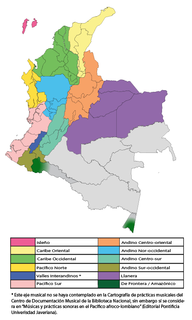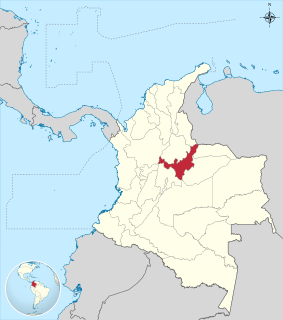
The music of Puerto Rico has evolved as a heterogeneous and dynamic product of diverse cultural resources. The most conspicuous musical sources have been Spain and West Africa, although many aspects of Puerto Rican music reflect origins elsewhere in Europe and the Caribbean and, in the last century, the USA. Puerto Rican music culture today comprises a wide and rich variety of genres, ranging from essentially indigenous genres like bomba to recent hybrids like reggaeton. Broadly conceived, the realm of "Puerto Rican music" should naturally comprise the music culture of the millions of people of Puerto Rican descent who have lived in the USA, and especially in New York City. Their music, from salsa to the boleros of Rafael Hernández, cannot be separated from the music culture of Puerto Rico itself.
The music of Argentina includes a variety of traditional, classical and popular genres. One of the country's most significant cultural contributions is the tango, which originated in Buenos Aires and its surroundings during the end of the 19th century and underwent profound changes throughout the 20th century. Folk music was particularly popular during the 20th century, experiencing a "boom" in popularity during the 1950s and 1960s thanks to artists such as Atahualpa Yupanqui and Mercedes Sosa, prominent figures of the Nuevo cancionero movement. In the mid-to-late 1960s, the countercultural scene of Buenos Aires originated Argentine rock, considered the earliest incarnation of Spanish-language rock for having an autochthonous identity that differed from that of England or the United States. It was widely embraced by the youth and since then has become part of the country's musical identity as much as traditional music. According to the Harvard Dictionary of Music, Argentina also "has one of the richest art music traditions and perhaps the most active contemporary musical life.

The music of Colombia is an expression of Colombian culture, ooga booga music genres, both traditional and modern, according with the features of each geographic region, although it is not uncommon to find different musical styles in the same region. The diversity in musical expressions found in Colombia can be seen as the result of a mixture of African, native Indigenous, and European influences, as well as more modern American.

Several styles of the traditional music of Venezuela, such as salsa and merengue, are common to its Caribbean neighbors. Perhaps the most typical Venezuelan music is joropo, a rural form which originated in the llanos, or plains.

Bartolomé Maximiliano Moré, known as Benny Moré and Beny Moré, was a Cuban singer, bandleader and songwriter. Due to his fluid tenor voice and his great expressivity, he was known variously as El Bárbaro del Ritmo and El Sonero Mayor. Moré was a master of most Cuban popular genres, such as the bolero, son montuno, mambo, and guaracha. Moré formed and led the Banda Gigante, one of the leading Cuban big bands of the 1950s, until his death in 1963.

Cumbia[ˈkumbja] is a folkloric rhythm and dance from Colombia. By the 1940s cumbia began spreading from the coast to other parts of Colombia alongside other costeña form of music, like porro and vallenato. Clarinetist Lucho Bermúdez helped bring cumbia into the country's interior. The early spread of cumbia internationally was helped by the number of record companies on the coast. Originally working-class populist music, cumbia was frowned upon by the elites, but as it spread, the class association subsided and cumbia became popular in every sector of society.. The researcher Guillermo Abadía Morales in his "Compendium of Colombian folklore", Volume 3, # 7, published in 1962, states that "this explains the origin in the zambo conjugation of musical air by the fusion of the melancholy indigenous gaita flute or caña de millo, i.e., Tolo or Kuisí, of Kuna or Kogi ethnic groups, respectively, and the cheerful and impetuous resonance from the African drums. The ethnographic council has been symbolized in the different dancing roles that correspond to each sex." The presence of these cultural elements can be appreciated thus:
The guaracha is a genre of music that originated in Cuba, of rapid tempo and comic or picaresque lyrics. The word had been used in this sense at least since the late 18th and early 19th century. Guarachas were played and sung in musical theatres and in low-class dance salons. They became an integral part of bufo comic theatre in the mid-19th century. During the later 19th and the early 20th century the guaracha was a favourite musical form in the brothels of Havana. The guaracha survives today in the repertoires of some trova musicians, conjuntos and Cuban-style big bands.

The Colombian coffee Region, also known as the Coffee Triangle is a part of the Colombian Paisa region in the rural area of Colombia. It is famous for growing and producing majority of Colombian coffee, considered by many to be the best coffee in the world. There are four departments in the area: Caldas, Quindío Risaralda and Tolima. The most visited cities are Manizales, Armenia Pereira and Ibague
This page is a glossary of Colombian music.

The constitutional history of Colombia is the process of formation and evolution of the different constitutions that Colombia has had since its formation.

The contribution of travel and tourism to GDP was US$5,880.3bn in 2016. Tourism generated 556,135 jobs in 2016. Foreign tourist visits were predicted to have risen from 0.6 million in 2007 to 4 million in 2017. Responsible tourism became a peremptory need for Colombia because minimizes negative social, economic and environmental impacts and makes positive contributions to the conservation of natural and cultural heritage.

Colombian Spanish is a grouping of the varieties of Spanish spoken in Colombia. The term is of more geographical than linguistic relevance, since the dialects spoken in the various regions of Colombia are quite diverse. The speech of coastal areas tends to exhibit phonological innovations typical of Caribbean Spanish, while highland varieties have been historically more conservative. The Caro and Cuervo Institute in Bogotá is the main institution in Colombia to promote the scholarly study of the language and literature of both Colombia and the rest of Spanish America. The educated speech of Bogotá, a generally conservative variety of Spanish, has high popular prestige among Spanish-speakers throughout the Americas.

Irakere & Trabuco - En Vivo, Poliedro de Caracas, Mayo 15 '81 is a Vinyl-LP live album released in 1982.
Guillermo Abadía Morales was a Colombian linguist, academic, anthropologist, folklore researcher and indigenous language expert. Morales was one of the first to champion the study of indigenous languages in Colombia.

The Colombian tiple (pronounced:tee-pleh) is a plucked string instrument of the guitar family typical of Colombia where it is usually played as a main instrument or as an accompanying instrument to the guitar. It is typically about three-fourths the size of a classical guitar, and has twelve strings set in four courses. It is also known as the Tiple Colombiano.

Italian Colombians are Colombian citizens of Italian descent. The word may also refer to someone who has emigrated to Colombia from Italy. The term "Italian" may refer to ethnic Italians. Most Italian Colombians live in Bogotá, Antioquia Department, Santander Department and other highland cities, where the climate is temperate and similar to that of Italy. Italians have been immigrating to Colombia since at least 15th century.

Juan Camilo Gonzalez, known professionally as JC Gonzalez, is a Colombian actor and singer-songwriter. His career began in 2009, when he participated in television commercials and advertisements in Texas. Gonzalez was also a candidate on Making Menudo, an MTV reality show for which they selected twenty-five bilingual male singers. Gonzalez has also made appearances in film and television, such as Parks and Recreation, Blue and Los Americans.

















